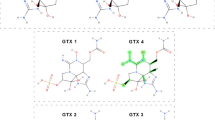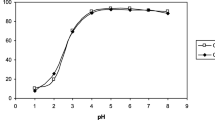Abstract
The technical feasibility of using stopper-derived cork as an effective biosorbent towards bivalent mercury at environmentally relevant concentrations and conditions was evaluated in this study. Only 25 mg/L of cork powder was able to achieve 94 % of mercury removal for an initial mercury concentration of 500 μg/L. It was found that under the conditions tested, the efficiency of mercury removal expressed as equilibrium removal percentage does not depend on the amount of cork or its particle size, but is very sensitive to initial metal concentration, with higher removal efficiencies at higher initial concentrations. Ion exchange was identified as one of the mechanisms involved in the sorption of Hg onto cork in the absence of ionic competition. Under ionic competition, stopper-derived cork showed to be extremely effective and selective for mercury in binary mixtures, while in complex matrices like seawater, moderate inhibition of the sorption process was observed, attributed to a change in mercury speciation. The loadings achieved are similar to the majority of literature values found for other biosorbents and for other metals, suggesting that cork stoppers can be recycled as an effective biosorbent for water treatment. However, the most interesting result is that equilibrium data show a very rare behaviour, with the isotherm presenting an almost square convex shape to the concentration axis, with an infinite slope for an Hg concentration in solution around 25 μg/L.







Similar content being viewed by others

References
Al Rmalli SW, Dahmani AA, Abuein MM, Gleza AA (2008) Biosorption of mercury from aqueous solutions by powdered leaves of castor tree (Ricinus communis L.). Journal of Hazardous Materials 152 (3):955–959. doi:10.1016/j.jhazmat.2007.07.111
Anirudhan TS, Divya L, Ramachandran M (2008) Mercury(II) removal from aqueous solutions and wastewaters using a novel cation exchanger derived from coconut coir pith and its recovery. Journal of Hazardous Materials 157(2–3):620–627. doi:10.1016/j.jhazmat.2008.01.030
Bayramoğlu G, Arıca MY (2008) Removal of heavy mercury(II), cadmium(II) and zinc(II) metal ions by live and heat inactivated Lentinus edodes pellets. Chemical Engineering Journal 143 (1–3):133–140. doi:10.1016/j.cej.2008.01.002
Cardoso SP, Lopes CB, Pereira E, Duarte AC, Silva CM (2013) Competitive removal of Cd2+ and Hg2+ ions from water using titanosilicate ETS-4: kinetic behaviour and selectivity. Water Air and Soil Pollution 224 (5). doi: 10.1007/s11270-013-1535-z
Chubar N, Carvalho JR, Correia MJN (2003) Cork biomass as biosorbent for Cu(II), Zn(II) and Ni(II). Colloids and Surfaces A: Physicochemical and Engineering Aspects 230 (1–3):57–65. doi: 10.1016/j.colsurfa.2003.09.014
Chubar N, Carvalho JR, Correia MJN (2004) Heavy metals biosorption on cork biomass: effect of the pre-treatment. Colloids and Surfaces A: Physicochemical and Engineering Aspects 238 (1–3):51–58. doi: 10.1016/j.colsurfa.2004.01.039
Cordeiro N, Belgacem MN, Silvestre AJD, Neto CP, Gandini A (1998) Cork suberin as a new source of chemicals. 1. Isolation and chemical characterization of its composition. International Journal of Biological Macromolecules 22(2):71–80. doi:10.1016/s0141-8130(97)00090-1
Do DD (1998) Adsorption analysis: equilibria and kinetics. Imperial College Press, London
European Parliament C (2008) Directive 2008/105/EC of the European Parliament and of the Council of 16 December 2008 on environmental quality standards in the field of water policy, amending and subsequently repealing Council Directives 82/176/EEC, 83/513/EEC, 84/156/EEC, 84/491/EEC, 86/280/EEC and amending Directive 2000/60/EC of the European Parliament and of the Council. Official Journal of the European Union
Farooq U, Kozinski JA, Khan MA, Athar M (2010) Biosorption of heavy metal ions using wheat based biosorbents—a review of the recent literature. Bioresource Technology 101 (14):5043–5053. doi:10.1016/j.biortech.2010.02.030
Figueira P, Lopes CB, Daniel-da-Silva AL, Pereira E, Duarte AC, Trindade T (2011) Removal of mercury (II) by dithiocarbamate surface functionalized magnetite particles: application to synthetic and natural spiked waters. Water Research 45(17):5773–5784. doi:10.1016/j.watres.2011.08.057
Fiol N, Villaescusa I, Martinez M, Miralles N, Poch J, Serarols J (2003) Biosorption of Cr(VI) using low cost sorbents. Environmental Chemistry Letters 1(2):135–139. doi:10.1007/s10311-003-0027-6
Gandini A, Pascoal C, Silvestre AJD (2006) Suberin: a promising renewable resource for novel macromolecular materials. Progress in Polymer Science 31(10):878–892. doi:10.1016/j.progpolymsci.2006.07.004
Ghodbane I, Hamdaoui O (2008) Removal of mercury(II) from aqueous media using eucalyptus bark: kinetic and equilibrium studies. Journal of Hazardous Materials 160(2–3):301–309. doi:10.1016/j.jhazmat.2008.02.116
Gil L (1997) Cork powder waste: an overview. Biomass and Bioenergy 13 (1–2):59–61. doi:10.1016/S0961-9534(97)00033-0
Ho YS, McKay G (1999) Pseudo-second order model for sorption processes. Process Biochemistry 34(5):451–465. doi:10.1016/s0032-9592(98)00112-5
Iftikhar AR, Bhatti HN, Hanif MA, Nadeem R (2009) Kinetic and thermodynamic aspects of Cu(II) and Cr(III) removal from aqueous solutions using rose waste biomass. J Hazard Mater 161(2–3):941–947. doi:10.1016/j.jhazmat.2008.04.040
Kadirvelu K, Goel J, Rajagopal C (2008) Sorption of lead, mercury and cadmium ions in multi-component system using carbon aerogel as adsorbent. Journal of Hazardous Materials 153(1–2):502–507. doi:10.1016/j.jhazmat.2007.08.082
Kahraman S, Asma D, Erdemoglu S, Yesilada O (2005) Biosorption of copper(II) by live and dried biomass of the white rot fungi Phanerochaete chrysosporium and Funalia trogii. Engineering in Life Sciences 5(1):72–77. doi:10.1002/elsc.200420057
Karunasagar D, Balarama Krishna MV, Rao SV, Arunachalam J (2005) Removal and preconcentration of inorganic and methyl mercury from aqueous media using a sorbent prepared from the plant Coriandrum sativum. Journal of Hazardous Materials 118 (1–3):133–139. doi:10.1016/j.jhazmat.2004.10.021
Kratochvil D, Volesky B (1998) Advances in the biosorption of heavy metals. Trends in Biotechnology 16 (7):291–300. doi:10.1016/S0167-7799(98)01218-9
Lagergren S (1898) About the theory of so-called adsorption of soluble substances. Kungliga Svenska Vetenskapsakademiens Handlingar 24(4):39
Lopes CB, Figueira P, Tavares DS, Lin Z, Daniel-Da-Silva AL, Duarte AC, Rocha J, Trindade T, Pereira E (2013) Core–shell magnetite-silica dithiocarbamate-derivatised particles achieve the Water Framework Directive quality criteria for mercury in surface waters. Environmental Science and Pollution Research 20 (9). doi:10.1007/s11356-013-1615-z
Lopes CB, Otero M, Lin Z, Silva CM, Pereira E, Rocha J, Duarte AC (2010) Effect of pH and temperature on Hg(2+) water decontamination using ETS-4 titanosilicate. Journal of Hazardous Materials 175(1–3):439–444. doi:10.1016/j.jhazmat.2009.10.025
Lopes CB, Otero M, Lin Z, Silva CM, Rocha J, Pereira E, Duarte AC (2009) Removal of Hg(2+) ions from aqueous solution by ETS-4 microporous titanosilicate—kinetic and equilibrium studies. Chemical Engineering Journal 151(1–3):247–254. doi:10.1016/j.cej.2009.02.035
Lopez-Mesas M, Navarrete ER, Carrillo F, Palet C (2011) Bioseparation of Pb(II) and Cd(II) from aqueous solution using cork waste biomass. Modeling and optimization of the parameters of the biosorption step. Chemical Engineering Journal 174(1):9–17. doi:10.1016/j.cej.2011.07.026
Low MJD (1960) Kinetics of chemisorption of gases on solids. Chemical Reviews 60(3):267–312. doi:10.1021/cr60205a003
Machado R, Carvalho JR, Correia MJN (2002) Removal of trivalent chromium(III) from solution by biosorption in cork powder. Journal of Chemical Technology and Biotechnology 77(12):1340–1348. doi:10.1002/jctb.724
Ofomaja AE, Ho YS (2007) Effect of pH on cadmium biosorption by coconut copra meal. Journal of Hazardous Materials 139(2):356–362. doi:10.1016/j.jhazmat.2006.06.039
Otero M, Lopes CB, Coimbra J, Ferreira TR, Silva CM, Lin Z, Rocha J, Pereira E, Duarte AC (2009) Priority pollutants (Hg(2+) and Cd(2+)) removal from water by ETS-4 titanosilicate. Desalination 249(2):742–747. doi:10.1016/j.desal.2009.04.008
Pinto P, Sousa AR, Silvestre AJD, Neto CP, Gandini A, Eckerman C, Holmbom B (2009) Quercus suber and Betula pendula outer barks as renewable sources of oleochemicals: a comparative study. Industrial Crops and Products 29(1):126–132. doi:10.1016/j.indcrop.2008.04.015
Psareva TS, Zakutevskyy OI, Chubar NI, Strelko VV, Shaposhnikova TO, Carvalho JR, Correia MJN (2005) Uranium sorption on cork biomass. Colloids and Surfaces A: Physicochemical and Engineering Aspects 252(2–3):231–236. doi:10.1016/j.colsurfa.2004.10.115
ReCORK (2011). http://recork.org/faqs/. Accessed 13 Mar 2013
Riaz M, Nadeem R, Hanif MA, Ansari TM, Rehman KU (2009) Pb(II) biosorption from hazardous aqueous streams using Gossypium hirsutum (cotton) waste biomass. J Hazard Mater 161(1):88–94. doi:10.1016/j.jhazmat.2008.03.096
Rocha L, Lopes C, Borges JA, Duarte AC, Pereira E (2013a) Valuation of unmodified rice husk waste as an eco-friendly sorbent to remove mercury: a study using environmental realistic concentrations. Water, Air, & Soil Pollution 224(7):1–18. doi:10.1007/s11270-013-1599-9
Rocha L, Lopes C, Henriques B, Tavares D, Borges JA, Duarte AC, Pereira E (2013) Competitive effects on mercury removal by an agricultural waste: application to synthetic and natural spiked waters. Environmental Technology. doi:10.1080/09593330.2013.841267
Rocha SM, Goodfellow BJ, Delgadillo I, Neto CP, Gil AM (2001) Enzymatic isolation and structural characterisation of polymeric suberin of cork from Quercus suber L. International Journal of Biological Macromolecules 28(2):107–119. doi:10.1016/s0141-8130(00)00163-x
Sari A, Tuzen M (2009) Removal of mercury(II) from aqueous solution using moss (Drepanocladus revolvens) biomass: equilibrium, thermodynamic and kinetic studies. Journal of Hazardous Materials 171(1–3):500–507. doi:10.1016/j.jhazmat.2009.06.023
SICNoticias (2013). http://sicnoticias.sapo.pt/programas/economiaverde/2013/03/22/reciclar-rolhas-usadas. Accessed 2 Apr 2013
Silvestre AJD, Neto CP, Gandini A (2011) Cork and suberins: major sources, properties, applications. In: Belgacem MN, Gandini A (eds) Monomers, polymers and composites from renewable resources. Elsevier, Amsterdam, pp 305–320
Sousa AF, Pinto P, Silvestre AJD, Neto CP (2006) Triterpenic and other lipophilic components from industrial cork byproducts. Journal of Agricultural and Food Chemistry 54(18):6888–6893. doi:10.1021/jf060987+
Sulaymon AH, Ebrahim SE, Abdullah SM, Al-Musawi TJ (2010) Removal of lead, cadmium, and mercury ions using biosorption. Desalin Water Treat 24(1–3):344–352. doi:10.5004/dwt.2010.1963
Vilela C, Sousa AF, Freire CSR, Silvestre AJD, Pascoal Neto C (2013) Novel sustainable composites prepared from cork residues and biopolymers. Biomass and Bioenergy 55 (0):148–155. doi:10.1016/j.biombioe.2013.01.029
Villaescusa I, Martinez M, Miralles N (2000) Heavy metal uptake from aqueous solution by cork and yohimbe bark wastes. Journal of Chemical Technology and Biotechnology 75(9):812–816. doi:10.1002/1097-4660(200009)75:9<812::aid-jctb284>3.3.co;2-2
Wang XS, Li FY, He W, Miao HH (2010) Hg(II) removal from aqueous solutions by Bacillus subtilis biomass. Clean-Soil Air Water 38(1):44–48. doi:10.1002/clen.200900201
Zhao P, Guo X, Zheng C (2010) Removal of elemental mercury by iodine-modified rice husk ash sorbents. Journal of Environmental Sciences 22 (10):1629–1636. doi:10.1016/S1001-0742(09)60299-0
Acknowledgments
The authors thank Fundação para a Ciência e a Tecnologia (FCT) (PTDC/MAR-BIO/3533/2012; PEst-C/MAR/LA0017/2011), FSE and POPH for funding. The authors C.B. Lopes and L.S. Rocha also thank their Post-DOC grants (SFRH/BD/45156/2008; SFRH/BD/47166/2008).
Author information
Authors and Affiliations
Corresponding author
Additional information
Responsible editor: Bingcai Pan
Electronic supplementary material
Below is the link to the electronic supplementary material.
ESM 1
(DOCX 77 kb)
Rights and permissions
About this article
Cite this article
Lopes, C.B., Oliveira, J.R., Rocha, L.S. et al. Cork stoppers as an effective sorbent for water treatment: the removal of mercury at environmentally relevant concentrations and conditions. Environ Sci Pollut Res 21, 2108–2121 (2014). https://doi.org/10.1007/s11356-013-2104-0
Received:
Accepted:
Published:
Issue Date:
DOI: https://doi.org/10.1007/s11356-013-2104-0



